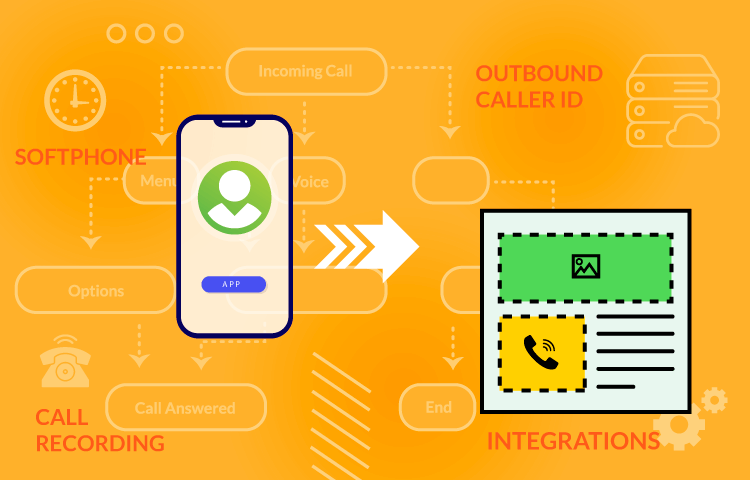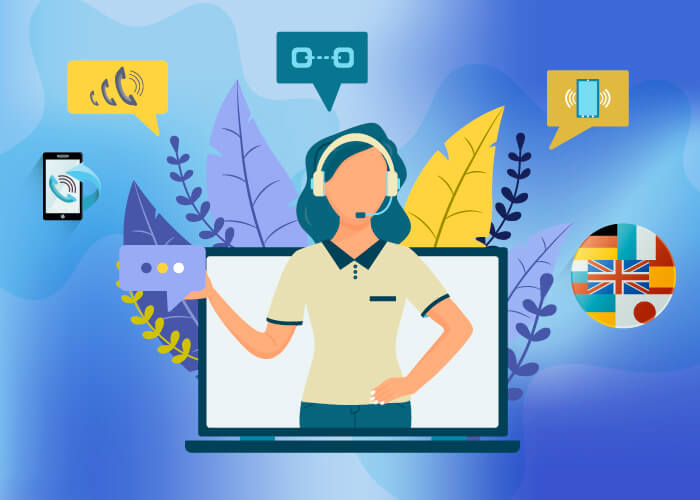Improved customer experience can result in approximately a 15% boost in sales conversions. And to provide stellar customer experiences, you need to support your sales and support teams with the right tools and technology.
That’s where blended call center software may come in handy.
Blended call centers seamlessly integrate both inbound and outbound calling functions so you can assist customers across different buyer journeys. From providing advanced call management tools to flexibility in workforce management, there’s so much that blended models can do for your business.
In this article, we’ll go over what a blended call center is and the essential technologies to run one, such as:
- International Phone Numbers
- Call Forwarding and Routing
- IVR and Call Flows
- Softphone and Web Dialers
- Outbound Caller ID
- Call Recording
- Call Reports and Analytics
- VoIP Integrations
What is a Blended Call Center?
Blended call centers combine inbound and outbound call services in a single setup. This is different from traditional call centers that specialize in either inbound (handling incoming customer inquiries) or outbound (initiating calls for sales, follow-ups, etc.) services.
In this setup, agents handle incoming calls as well as make outgoing calls to support all call center and business communication needs. By integrating both, agents handle a diverse range of tasks from resolving customer issues to conducting proactive outreach campaigns. This further ensures optimal resource utilization while maximizing customer service levels.
So, why is this holistic approach to customer service management good for your call center?
Benefits of Blending Inbound and Outbound Call Services
Blended services offer a range of benefits—including improved efficiency, scalability, and service levels. Above all else, blended call center tech is capable of adapting to evolving business needs, supporting expansion, thereby, driving growth.
Here are some of the key benefits of blending inbound and outbound services:
- Access a variety of inbound and outbound calling solutions and features to manage all business phone communications.
- Use inbound calling features like call routing, IVR, etc to improve call handling and caller experience.
- Leverage outbound calling features like caller ID management, softphones, etc. to increase response rates and sales efficiency.
- Increase the chances of upselling and cross-selling since agents handle both incoming support and outgoing sales calls, they have more opportunities to talk to customers about products and services across different points in the customer journey.
- Assign agents to inbound or outbound calls based on real-time call volume fluctuations to reduce wait times and provide more prompt service.
- Analyze call center data and reports to improve agent utilization and allocate resources effectively across different channels and shifts.
8 Essential Blended Call Center Technologies
You will need an arsenal of cutting-edge call handling techs and features in order to run a blended call center.
From delivering sophisticated customer experience to helping you make staffing decisions, here are 8 blended call center technologies that can shape effective business operations:
- International Phone Numbers
- Call Forwarding and Routing
- IVR and Call Flows
- Softphone and Web Dialers
- Outbound Caller ID
- Call Recording
- Call Reports and Analytics
- VoIP Integrations
1. International Phone Numbers
International phone numbers, such as local and toll-free numbers, from target countries offer businesses the opportunity to establish a global presence without needing physical offices in every region. Customers can comfortably call designated business phone numbers, no matter where the business, main office, or service centers are located. Simply forward incoming calls to your desired destinations.
But besides expanding reach, calling internationally with local numbers can improve outbound campaign efforts and inbound customer engagement. This is because local numbers have recognizable toll-free and area codes that encourage customers to answer or return your business’ calls.
Blended call centers can especially benefit from services like local 2-way voice that support incoming and outgoing calls via a local number. This means your teams can use the same virtual local phone number as their outbound caller ID. This helps improve customer trust and the likelihood of calls being answered. Additionally, if a call is missed or unanswered, the recipient can easily call back on the same number, simplifying follow-up and potentially leading to successful sales conversions.
This makes it easy to manage inbound (support) and outbound (sales) calls through one service. And if you have multiple locations, you can get multiple international phone numbers from one global provider and centralize communications.
Related: Inbound Sales Calls vs. Outbound Sales Calls
2. Call Forwarding and Routing
Call routing and forwarding are features that let you redirect inbound calls from one location to another strategically without incurring expensive international calling fees. These tools help you ensure that agents are available wherever your customers are located.
And you can leverage various routing strategies like time-of-day or location-based routing or simultaneous ringing to provide round-the-clock support. Blended models can prioritize agent allocation based on factors such as agent availability, customer preferences, etc. This prioritization also helps in improving first call resolution rates.
With optimized call handling, your agents can respond better to customer needs and prioritize outbound efforts for more urgent queries. It also frees up your agents whom you can then distribute to other areas of need.
3. IVR and Call Flows
Advanced call management solutions, such as automatic call distribution (ACD) and interactive voice response (IVR), help streamline call flows across multiple departments and locations.
ACD helps with routing incoming calls to the right agent based on factors like availability, skills, etc. On the other hand, you can set up automated IVR menus with menu options that callers use to navigate to the right agent.
These tools are generally quite customizable, ensuring you can effectively control and manage how calls travel within your phone network. They help reduce call queues and wait times while quickly connecting callers to the best possible agent for support.

4. Softphone and Web Dialers
Softphones, web dialers, and web phones are tools or apps that convert any device into a business phone. With a dial pad and call handling capabilities, these tools are a must for blended call centers, offering flexibility and convenience in managing calls from anywhere in the world. Simply put, you can make phone calls directly from a device or web browser like Chrome, Firefox, etc.
Agents can make and receive calls with a softphone on any IP-enabled devices, such as smartphones, laptops, etc. For example, the United World Telecom softphone can be downloaded on any Windows device. Users can then use the softphone app to
- Receive local and international VoIP calls
- Make outbound calls using local caller IDs
- Receive voicemails
- View call activity and history
- Transfer calls to other agents, and so on.
Some providers also offer softphone integrations with top CRMs and help desk software. With features like click-to-call, data sync, and in-app dialer, agents can get a comprehensive understanding of customer interactions. And managers can view and analyze agent performance and activity. This makes it easy to determine your inbound and outbound call flows and how to best optimize your customer experience efforts.
5. Outbound Caller ID
Caller ID management is important in ensuring your business calls are answered by your customers and prospects. Most people won’t answer calls by an unfamiliar number or one marked “Unknown.”
This is where the outbound caller ID feature comes in handy. By displaying a familiar or local phone number as the outbound caller ID, you can increase the chances of recipients answering calls. This could improve the success rates of outbound campaigns.
Now, if you have distributed and remote teams (aka, not working out of our main office), you may use a call masking feature to mask their actual outbound caller ID and use the business’ phone number instead. This way, your remote teams are also unified under the business’ phone network. This also protects agents’ personal phone numbers when using their own devices to place calls.
6. Call Recording
Call recording features can record both inbound and outbound calls. Blended call center supervisors can use these recordings to:
- Monitor agent performance
- Assess quality of customer service delivery
- Protect against liabilities
- Identify areas of improvement, and
- Ensure compliance with established standards and protocols.
Some providers, like United World Telecom, offer call recording add-ons like transcription and translation for increased accessibility.
7. Call Reports and Analytics
Other quality assurance-related features like call reports and analytics, too, provide overview of call traffic, agent distribution, service quality, and areas for improvement. You need these features to evaluate call center performance and make informed decisions. Measure key metrics like call volume, average handling time, customer satisfaction metrics, etc. for a real-time, deeper understanding of customer interactions.
And with call activity reports, you can reorganize call flows, routing strategies, staff goals, etc. in line with business goals. United World Telecom customers can view metrics such as call duration, agent activity, calling charges, caller locations, and more to understand caller habits better.
Related: Tips for Running a Successful Virtual Call Center
8. VoIP Integrations
VoIP integrations with CRMs and help desk software can streamline call operations. These integrations come with features like call logging and data sync that automatically sync call records and contacts between the two platforms. This saves agents time and manual effort and ensures accurate record-keeping. Additionally, managers and agents can review customer interaction histories, follow-up tasks, and call recordings directly from the CRM interface.
How Can United World Telecom Help?
The right blended call center tech and tools can make or break your call handling strategy. And this directly affects the bottom line. Wondering what call management capabilities are right for your call center?
Talk to us! United World Telecom has been helping international enterprises and small businesses with state-of-the-art communication solutions. Our call center solutions provide you with a range of services and features to manage inbound and outbound calls and connect with your local and international customers reliably.
We can help you upgrade your telephony system to drive call center growth. Connect with our experts today and learn more about call center essentials!


